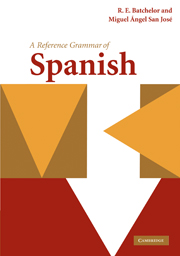Book contents
- Frontmatter
- Contents
- Preface/Prólogo
- Acknowledgments/Agradecimientos
- Abbreviations/Abreviaturas
- Introduction to the Spanish language/Introducción a la lengua española
- Part I
- 1 Register/Registro
- 2 Alphabet, spelling, pronunciation/Alfabeto, ortografía, pronunciación
- 3 Stress and accent marks/Acento tónico y acento ortográfico
- 4 Punctuation, upper case, lower case/Puntuación, mayúsculas, minúsculas
- 5 Apocopation/Apócope
- 6 Agreement/Concordancia
- Part II
- Part III
- Part IV
- Part V
- Part VI
- Part VII
- Part VIII
- Part IX
- Part X
- Appendix I Verb tables/ Tablas de verbos
- Appendix II Glossary/Glosario
- Bibliography/Bibliografía
- General index/Índice general
- Subjunctive index/Índice del subjuntivo
4 - Punctuation, upper case, lower case/Puntuación, mayúsculas, minúsculas
from Part I
Published online by Cambridge University Press: 05 June 2012
- Frontmatter
- Contents
- Preface/Prólogo
- Acknowledgments/Agradecimientos
- Abbreviations/Abreviaturas
- Introduction to the Spanish language/Introducción a la lengua española
- Part I
- 1 Register/Registro
- 2 Alphabet, spelling, pronunciation/Alfabeto, ortografía, pronunciación
- 3 Stress and accent marks/Acento tónico y acento ortográfico
- 4 Punctuation, upper case, lower case/Puntuación, mayúsculas, minúsculas
- 5 Apocopation/Apócope
- 6 Agreement/Concordancia
- Part II
- Part III
- Part IV
- Part V
- Part VI
- Part VII
- Part VIII
- Part IX
- Part X
- Appendix I Verb tables/ Tablas de verbos
- Appendix II Glossary/Glosario
- Bibliography/Bibliografía
- General index/Índice general
- Subjunctive index/Índice del subjuntivo
Summary
Here is a passage illustrating many of the features of Spanish punctuation. Note particularly lower case for days and months, the upside-down symbols for exclamation and question marks, and italics for names of books. Note also the difference between upper and lower case in the Paseo del Prado and the sierra de Guadarrama, explained in the text.
E| domingo pasado, último de mayo, me acerqué a la Cuesta de Moyano, lugar cercano al Paseo del Prado y de la Estación de Mediodía.
Desde niño he disfrutado hojeando libros en este paraíso de bibliólos: extraños personajes de brillantes ojos y pulso acelerado ante la perspectiva de hurgar entre los libros apilados.
–¿Qué vale éste? –pregunto al librero, señalando un ejemplar de La venganza de Don Mendo (caricatura de tragedia en cuatro jornadas) de Muñoz Seca.
–Vea en la contraportada –me responde, con aire afable.
Abro el libro y leo la esquina superior: 2,5 euros; más abajo: “A mi apreciable amigo y condiscípulo D. Anselmo Rubio, 2-1-1975”, después una firma ilegible.
–¡Es una ganga! [gift, real find]. Esta obra es bastante difícil de encontrar –me dice el hombre, mirándome directamente a través de sus gafas en equilibrio inestable en el extremo de su diminuta nariz.
Me viene a la memoria la fotografía del autor cómico, inventor de aquel género teatral nuevo –“el astracán”–cuyo objetivo último era arrancar la risa al espectador: hombre elegante, metódico, de profunda moralidad, que triunfó durante diez años seguidos con sus graciosísimas obras en toda España...
- Type
- Chapter
- Information
- A Reference Grammar of Spanish , pp. 30 - 37Publisher: Cambridge University PressPrint publication year: 2010

